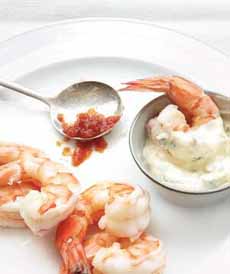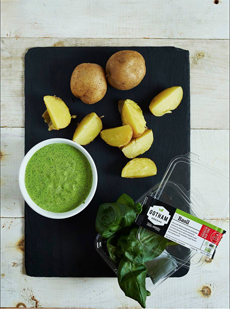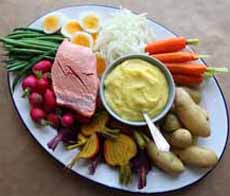TIP OF THE DAY: Aïoli, The Original, The Modern, Easy Recipe & A Party
|
|
Americans eat a lot of mayonnaise, but not enough aïoli: garlic mayonnaise. The word is pronounced eye-OH-lee from the French word for garlic, ail (pronounced EYE). An easy recipe using store-bought mayonnaise is below. What we think of as a bread spread is used as a dip and sauce from Catalonia (the northeast tip of Spain; think Barcelona) through Provence (Marseilles along the coast through Toulon, Cannes, Nice and Monaco. It hopped the border of Monaco to the Liguria region of Italy. It spread to the south of Catalonia to Valencia, Catalonia, Murcia and eastern Andalusia, and offshore to the Balearic Islands. It crossed the sea to Malta. In fact, mayonnaise was invented in France by the great chef Marie-Antoine Carême, around 1800. You may think of mayo as a spread, but it was created as a sauce (the history of mayonnaise). But before then, the original sauce was made with just garlic and olive oil, which, by the way, was not an easy combination to emulsify into a sauce in the centuries before blenders. Later, possibly inspired by Carême’s mayonnaise, Provençal cooks incorporated egg yolks and lemon juice and voila: a richer, more flavorful, more stable mixture than mashed garlic and olive oil. (When you look at your food processor or blender, remember that everything prior to modern times was done in a mortar and pestle.) There are numerous seasoning variations. In France, it can include a bit of Dijon mustard. In Malta, some tomato is added. Everywhere, aïoli is served at room temperature. Ingredients vary by region, too. Catalan versions leave out the egg yolk and use much more garlic. This gives the sauce a more pasty texture, while making it considerably more laborious to make as the emulsion is much harder to stabilize. Yes, you can put it on your sandwich or burger; but aïoli can be used instead of mayonnaise anywhere, from canapés to to dips to potato salad. You can even plan a luncheon or dinner party around it. And you can buy it or make it. Then, serve it: In Provence, Le Grand Aïoli (a.k.a. Aïoli Garni or Aïoli Monstre) is a special-occasion dish consisting of boiled vegetables (artichokes, beets, carrots, green beans, potatoes); salt cod or other poached fish, snails, canned tuna, other seafood; hard-boiled eggs, and a large dish of aïoli. In Provence, the dish is served in a celebration around August 15th, after the garlic has been harvested. If you like the idea, plan an occasion. You don’t have to wait until August. A room-temperature dish, Le Grand Aïoli delightful in the spring or summer with a lightly-chilled Côtes de Provence rosé or a red Bandol. If you like crème de cassis (cassis liqueur, made from blackcurrants), it’s a local product; so serve a Kir or Kir Royale as an aperitif. Aioli, aïoli, alhòli, aiòli or allioli, arjoli or ajjoli: Depending on the country and region, they are different spellings for a Mediterranean sauce (in southeastern Spain, it’s called ajoaceite or ajiaceite). Made of garlic and olive oil—two staple ingredients of the area—the name means garlic and oil in Catalan and Provençal. |
|
|
There are numerous flavored mayonnaises. Since the expansion of specialty food producers in the late 1980s, it became fashionable for producers and chefs to call all flavored mayonnaises—basil, chili, cilantro, red pepper, saffron, etc.—aïoli. While purists insist that only the garlic-seasoned recipe should be called “aïoli,” we think, logically, that as long as there’s garlic in the recipe, it can still be called aïoli. Consumers will understand. Otherwise, you’ll find even purer purists who insist that only the original garlic-oil sauce—no egg, no lemon juice—be called aïoli. If you want to make your aïoli from scratch, here’s a recipe. If you want to cut calories, use Greek yogurt for a different take. Ingredients For 1 Cup 1. BLANCH the basil in boiling water for 15 seconds. Mix all ingredients in medium bowl. Season to taste with salt and pepper. 2. REFRIGERATE, covered, for at least 1 hour or overnight, to allow flavors to meld. ________________ *If you want a spice instead of an herb, season to taste. |
||







